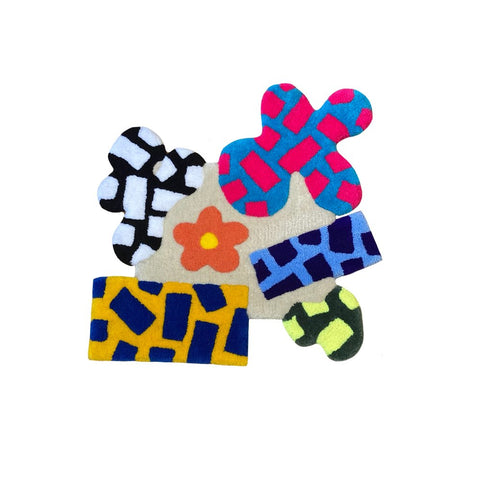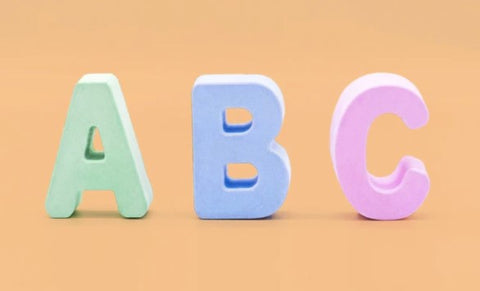-
Shop
-
Learn to tuft
- Help Center
-
About
- Reflect Rewards
- Custom rugs
- Get a discount
-
April 27, 2023
Tuft the World is turning 5 years old!
We are so grateful to have spent 5 years building this little tufting community in Philadelphia and connecting with people around the world. Our 5th year has seen many new things for Tuft The World.
In March 2023, we hosted the first ever TuftCon, a three day event that hosted over 100 people with a one of a kind line-up of guest speakers, demos, workshops, and more. Tuft the World also set up a robotic tufting machine and started using artificial intelligence to create larger tufted projects for people across the country and beyond. Tuft's robotic tufting machine can create a tufted piece that is 10 x 13 feet. Stay tuned for how to collaborate with us!
In April 2023, we officially opened our new education space in the Bok Building in South Philadelphia! In addition to the regular Intro to tufting workshops, we’ve added project-based tufting workshops, advanced tufting, a number of other fiber-arts classes and a summer camp for the kiddos!
And of course, we continue all our sustainability initiatives, such as planting trees with every order, using the most eco-friendly materials possible, limiting our waste, and continuing the second year of Shred the World.
TuftCon 2023
Our first tufting event in Philadelphia is over, we can’t believe it. Tuft the World is so excited to have been able to put on this event and cannot wait to do it again, TuftCon 2024!

CNC Tufter
After many years of waiting, Tuft the World finally has a CNC tufter, aka the Robo Tufter. This fully automated machine can make rugs up to 10 x 13 feet! We are excited to partner with people in the future to make their tufted rug designs come true.

Tuft Ed Studio
The Tuft Education Studio is located in the Bok Building in the heart of South Philadelphia and is a place for makers! We offer tufting classes and adult and youth fiber-based workshops, including summer camp. Our studio space includes a 50’ long screen-printing table, large work tables, and a large washout sink for ink and dye-based projects. Located in the Bok Building, TTW Ed Studio is surrounded by a community of other makers and creative events. Stop by and visit us, along with any of our neighbors!
TTW Ed Studio staff includes experienced educators and crafters. Providing access to quality fiber and textile-based workshops, to makers of all ages, is at the core of our educational mission. We believe that creative thinking is the seed of growth, and that everyone is innately creative.
Check out some of our upcoming classes:
For out-of-towners, have you considered taking our online class? Tuft from home with Tuft the World founder Tim Eads!

Tuft the World was established in 2018 by Tiernan Alexander and Tim Eads, Texas-born artists and business owners living and working in West Philadelphia. The company was founded to provide tufters with the high-quality tools, materials, and instruction they need to make their own tufting projects. Tiernan and Tim’s collective experience as crafters and educators, as well as their uniquely creative approach to art and life, inspire their mission to make the craft of tufting accessible to a broad audience, while staying true to their values of equity and sustainability.
We believe in people, community, and the health of our planet over profit. We’re committed to building a workplace ecosystem where our team can thrive, and in supporting and connecting a larger community of makers. We believe that creative thinking is the seed of growth, and that everyone is innately creative. It’s our hope that tufting might awaken that spirit in both the most confident artist, and the person who never thought they could make anything.
Since February 2021, 1% of every web shop sale is donated to a non-profit, beginning with several here in West Philadelphia. A new feature on our website allows you, Tuft customers, to participate in a “round up” at check-out, in support of an organization of your choice from a rotating list. And our team is working toward greater direct engagement with local orgs in and around Philadelphia by taking on a new giving project every six weeks. These have included letter-writing on behalf of refugees, canned food drives, book donations for incarcerated persons, and direct monetary donations. We’re excited to continue expanding this list over the coming months and years.
In November of 2022, Tuft the World started Shred the World, an avenue where we can upcycle a waste product that would otherwise be bound for the landfill. We continue to develop sustainable options to further our mission.
The first ever tufting convention, TuftCon was hosted by Tuft the World March 24-26, 2023 in Philadelphia, PA. TuftCon brought together over 100 people to learn, share and develop a deeper passion for tufting!
April 06, 2023
We love April because we get to celebrate Earth Day! Tuft the World strives to make earth-conscious choices wherever possible, both in our products and behind the scenes.
Our Reflect yarns are made with sustainable and recycled materials, and dyed here in the U.S.
1. Sturdy and soft, our Reflect Eco-cotton is entirely recycled yarn that gives knit textiles a second life. Made from off cuts of the t-shirt industry, the material is shredded and spun without being re-dyed. Yarn colors come from the original source material, which saves water and prevents pollution. Eco-cotton works well in all of our tufting machines and is also great for macrame, weaving, knitting and other crafts.

2. Chosen for its compatibility with our tufting machines, Reflect Wool comes form New Zealand and is small-batch dyed in the U.S. and sold on cardboard cones ready for your yarn feeder. Also great for use in punch-needle, embroidery, weaving, and other textile crafts.

3. Our Recycled Wool Yarn is perfect for threading alongside a thicker yarn like Reflect Wool or Eco-Cotton for a cool marbled look or interesting color variation. Made of 100% recycled wool and viscose, this is a sturdy but delicate fiber that is a great option for all your upcycling crafts.

4. A realistic eye, a watery surface, a glint on glass - our Banana Silk Yarn is a great way to add shimmer, color, and variation to your wall hanging or other decorative tuft. Made entirely from banana plant fiber, the delicate and slick texture of this yarn requires combining with a sturdier fiber, like Reflect Wool or Eco-Cotton, in order to create a dense pile. Banana Silk will be brightest in loop piles, while use in cut-pile pieces will allow for interesting flecks of shine. A fun yarn for adding embroidered or hand-sewn elements, too!


In lieu of plastic and as an antidote to over-packaging, we use compostable bags and minimal fill as often as we can. Thanks to our lovingly-named "Machine-that-eats-cardboard," Tuft the World now reuses its own carboard waste to insulate the majority of our products. Check out, Shred the World, an avenue where Tuft the World can upcycle our extra cardboard for other businesses to use!

In 2021, an employee-run Sustainability Committee formed to ensure that we add as little to landfills as possible. We're pleased to contract with local services like Bennett Compost, to lessen our office food and beverage waste, and Rabbit Recycling, who help us dispose of a range of materials beyond Philadelphia's standard recycling program.

Tuft the World knows that sustainability also means giving back, both environmentally and on the community level. In July 2022, Tuft joined the Sustainable Business Network of Greater Philadelphia, a local organization that brings together businesses with a focus on serving community needs, sharing wealth and protecting the environment. We sponsor the planting of one tree for every order placed in our store through Ecologi, a company combating climate change through reforestation projects around the world. Since July 2022, Tuft utilizes Planet, an app that helps us offset each shipment making our orders carbon neutral.
Come visit our Tuft Studio Grand Opening and Open Studios on Friday April 21, 2023 from 6-9pm in the Bok Building!
Catch us at the Davinci Art Alliance Everyday Futures Fest on Sunday April 22, 2023 from 1205pm.
Take a rug tufting class with us anytime! We have beginner and advanced rug tufting workshops online and in person.
February 23, 2023

Beginner Rug Tufting Classes at our studio in the Bok Building, Philly!
We have classes on Saturdays and Thursday evenings.
In this hands-on instructional class, participants will learn to use tufting guns to create a rug or wall hanging. The class will cover the basics of setting up a tufting frame with stretched primary cloth and threading and operating tufting machines. Instructions for how to cut, glue, and finish a tufted piece will also be provided.**

Participants will work on rug tufting projects of their own design on a frame that can accommodate pieces 22 x 22 inches.
Frame, cloth, and yarn are included in the cost of the workshop (participants will take their work and frames home following the class). Tuft the World will provide tufting machines for use during the workshop, or participants may bring their own.
**Basic finishing guidance is provided during the workshop, should participants choose to finish their tufted rug at home. Finishing supplies (backing cloth, edging trim, adhesive, etc.) are not included as part of the workshop.
These rug tufting classes are meant for everyone - our tufting guns are perfect for beginners, or if you’ve already gotten a tufting gun and are now looking for how to tuft, we’ve got you covered! Space is limited to 20 participants.

Tuft On the Road: Classes at other locations taught by Tuft the World
Sometimes Tuft the World travels! We like visiting other cities, connecting with different fiber arts-related businesses, and offering classes in new places. Here’s where our Tuft On the Road classes come in. The class is the same as our Beginner Rug Tufting workshop in Philly.

Advanced Rug Tufting Classes in Philadelphia
While we have many beginner tufting classes, new this year, we are adding an advanced class! This is an in-depth, 2 day workshop intended for folks who already know how to tuft. Is this you? Come visit us!

In this intermediate workshop, participants will learn finishing techniques to expand their basic tufting skills. The combined 10-hour class will include comprehensive instruction in cutting, gluing, and binding tufted rugs. Participants will also receive instruction in using finishing tools (carving clippers and electric carving scissors) to add dimension to their finished rugs.
Day 1: Participants will spend the first day tufting their designs. Cut, loop, and AK-III machines will be available. Participants will also learn how to “carve-as-you-tuft” to highlight areas of their designs. The first day will conclude with participants gluing the back of their rug(s).
Day 2: Participants will complete any desired carving using the finishing tools, then remove their rugs from the frames to glue on the backing felt and binding trim.
Participants will work on projects of their own design on a frame that can accommodate pieces 22 x 22 inches. It is suggested that participants also bring one completed rug to glue and finish.
Primary cloth, backing felt, binding trim, yarn, and adhesive are included in the cost of the workshop. Tuft the World will provide tufting machines for use during the workshop, or participants may bring their own. Finishing tools will also be provided for use during the workshop.
Open Studio - Book time to Tuft with Us!
And finally, something new we are launching very soon, Open studios! This format will allow folks who already know how to tuft, but don’t have the ability to invest in the time or space that tufting requires. Pay a fee to access our space, use our tufting guns and frames, bring your own yarn, or buy some from us and get tufting!

Want to tuft but not ready to invest in all the tools required? Don’t have the space to work? Come work on your tufting projects at the Tuft the World Open Studio! We’ll provide access to everything you need to tuft:
Open Studio does NOT include any tufting instruction. Previous tufting experience is required. You must include proof of your ability to tuft when registering. If you need tufting instruction, consider signing up for one of our beginner tufting workshops!
Participants can bring or buy their own consumable materials. Tuft the World will have the following available for purchase during Open Studio, at a discount:
All projects must be taken home at the end of Open Studio.
Check back later to see when we make Open Studio time available!
January 25, 2023
Join us March 24-26 at the first ever Tufting Convention, a Tufting Event in Philadelphia!
Tuft the World is thrilled to be presenting three days of exciting programming in Philadelphia, PA. Join us for demos, workshops, lectures, an open repair booth and more!
Your 3-day pass gives you access to three full days of tufting fun, education and networking! Join us at the Asian Arts Initiative on March 24 and 25 and at Tuft the World's new Education Space in the Bok Building on March 26 for more tufting, on-site shopping, product-testing, and the reception of our juried show of tufted artwork.
Demos & Workshops, Speakers, and Lectures!
Tuft the World staff will teach both beginner workshops as well as long awaited advanced workshop. We'll be hosting three lectures: Tonya D. Lee on Color Theory, Tim Eads and Tiernan Alexander on the past, present and future of Tuft the World, and Tiernan Alexander on the History of Rug Making. We'll have a panel discussion on starting a rug making business, and various demonstrations, including presentations by guest artists Trish Andersen and AJ Peterson. TuftCon will also boast an open repair booth for your technical needs and questions! The weekend will be a great environment for networking and connecting with fellow creatives, be sure to join us the first night for welcome drinks and mingling.

First and foremost, the making part of this big tufting event - demos and workshops! Get ready to learn everything you’ve ever wanted to learn about tufting!
There will be workshops for both beginner and advanced. *Workshops are limited and not guaranteed, please limit 1 workshop per ticket.
Additionally, you will have a number of demos to choose from. Demonstrations do not have limited space, so you can attend as many as you like.
See more info on Demos & Workshops at TuftCon here!

We are also excited to share some lectures with you:
See details about the lectures at TuftCon in Philadelphia here!

Tuft the World will also present a juried exhibition as part of TuftCon! The exhibition will be on view at the Bok Building, with an opening reception on the final day of TuftCon Sunday March 26, 2023. This is also a sneak peek into our new education space! Tuft the World is excited to have a dedicated space to offer beginner and advanced tufting workshops, in addition to all kinds of fiber arts classes. We look forward to hosting the juried exhibition here and can't wait to share this new additional Tuft the World location with you!
Here are the important dates to remember if you’re interested in submitting to the exhibition:
Submission deadline: Monday, February 13, 2023
Selected artists notified: Wednesday, March 1, 2023
Artwork drop-off: Monday, March 13, 2023
Exhibition Dates: March 26- April 30, 2023
Opening Reception: Sunday, March 26, 2023 (TuftCon ticket required *unless you are a selected artists)
Apply to the Exhibition here! (Deadline is February 13, 2023)
December 22, 2022
The first option is a common pricing method for handmade items, which is to add up the cost of your materials, plus an hourly labor rate, to give you the total cost to make the rug (you can think of this as the wholesale price). You choose your hourly rate, but we don’t think you should pay yourself less than $25 an hour.
Then you should add a markup! The markup gives you some wiggle room to be able to sell your items at a shop that might take a cut, or to pay yourself for the time you spend selling it.
This method gives you a clear breakdown of what everything costs in the process. But it also requires you to know all those things!
The second option is to just set a rate per square foot.
You can see in the spreadsheet that something between $50-75/square foot ends up giving you the same price as breaking everything down. This of course will change, based on your cost for labor (starting rate at $25 an hour, you deserve it, don't go lower than that!) and materials (wool is a lot more $$$ than acrylic and that should come through in the price)
To calculate how much yarn you might use in a rug, you can see our help center article here.

The spreadsheet should print on a single page, landscape. The excel sheet has all the formulas, so you can just enter numbers and it will add it all up for you!
Google sheets link (view only, but then you can make a copy and edit it)
June 10, 2022








March 24, 2022









February 17, 2022








December 16, 2021








November 16, 2021












October 21, 2021







August 17, 2021





